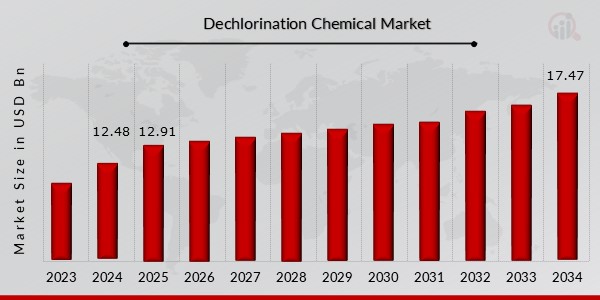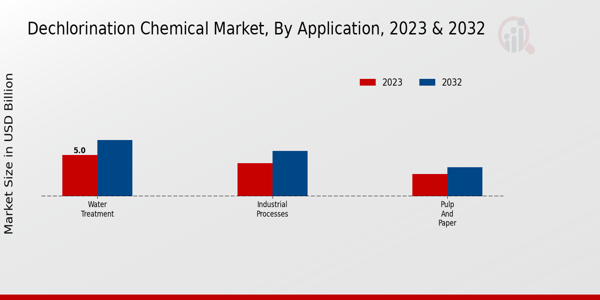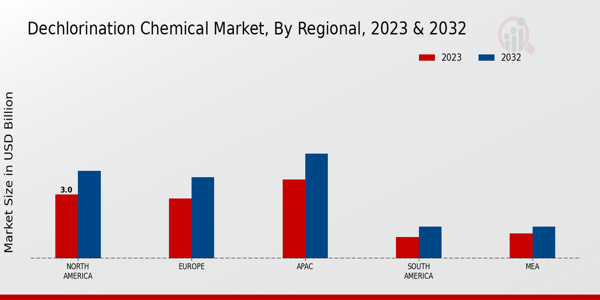Global Dechlorination Chemical Market Overview
The dechlorination chemical market size was estimated at 12.48(USD billion) in 2024. The dechlorination chemical industry is expected to grow from 12.91 (USD billion) in 2025 to 17.47 (USD billion) by 2034. The dechlorination chemical market CAGR (growth rate) is expected to be around 3.4% during the forecast period (2025 - 2034).
Key Dechlorination Chemical Market Trends Highlighted
The Dechlorination Chemical Market is experiencing significant growth driven by rising environmental concerns and stringent regulations on water treatment processes. Increasing awareness about the harmful effects of chlorine and chlorinated compounds in water has prompted industries to seek safer alternatives for water disinfection.
Additionally, the demand from various sectors, such as municipal water treatment, pharmaceuticals, and food processing, is pushing the adoption of dechlorination chemicals that are effective and eco-friendly. There are numerous opportunities for market players to explore, particularly in developing innovative dechlorination solutions that cater to specialized needs.
With advancements in technology, companies can develop more efficient dechlorination processes, which not only improve performance but also reduce costs. Furthermore, the shift towards sustainable practices in various industries presents a chance for businesses to position themselves as leaders in environmentally responsible solutions.
Partnerships with regulatory bodies can help in the development of guidelines that encourage the transition to safer dechlorination methods. In recent times, there has been a noticeable trend toward the integration of advanced technologies in water treatment, including the use of smart monitoring systems.
These innovations facilitate better tracking of chemical usage and enhance the effectiveness of dechlorination treatments. The emphasis on sustainability continues to influence consumer behavior, prompting industries to adopt greener practices in their operations.
The competitive landscape is evolving as companies look to invest in research and development, ensuring that they remain at the forefront of innovations in the dechlorination chemical market. This combination of technological advancements and a growing focus on environmental compliance is shaping the future of the industry.

Source: Primary Research, Secondary Research, Market Research Future Database and Analyst Review
Dechlorination Chemical Market Drivers
Increasing Water Treatment Regulations
The Dechlorination Chemical Market is significantly driven by the rising water treatment regulations enacted by governments and environmental agencies around the world.
As environmental awareness increases, regulatory authorities are implementing stringent guidelines to ensure water quality and safety. These regulations require industries and municipalities to treat wastewater effectively, leading to a higher demand for dechlorination chemicals that can remove chlorine from water sources.
The awareness of the adverse effects of chlorine on aquatic ecosystems and human health is propelling the push for more effective dechlorination processes.
This regulatory pressure not only encourages industries to adopt advanced dechlorination technologies, but also leads to innovation within the sector, as companies look for new solutions that meet or exceed compliance standards. This trend is anticipated to continue, bolstering the growth of the Dechlorination Chemical Market in the coming years.
Furthermore, as cities grow and populations increase, the demand for clean water rises, putting additional emphasis on effective treatment methods. The interplay between regulation and technological advancement ensures a robust market environment, making it essential for stakeholders to adapt and align with these transformations.
Growth in Municipal Water Treatment Facilities
The Dechlorination Chemical Market is witnessing significant growth due to the expansion and modernization of municipal water treatment facilities. As urban populations swell, the demand for reliable and safe drinking water has never been more crucial. Governments are investing heavily in upgrading existing infrastructure and building new facilities to keep pace with this demand.
This expansion requires the use of various dechlorination chemicals, as the removal of chlorine is essential to meet safety standards.
Enhanced infrastructure not only improves the quality of drinking water but also ensures that wastewater is treated efficiently before being released into the environment, further propelling the growth of the Dechlorination Chemical Market.
Rising Awareness of Environmental Protection
The increasing public consciousness regarding environmental issues is a vital driver for the Dechlorination Chemical Market. Individuals and organizations alike are becoming more aware of the environmental impacts of chemical discharges, including chlorinated compounds.
This awareness is stimulating demand for sustainable practices in industry operations, prompting businesses to seek eco-friendly dechlorination solutions. Consequently, the market for dechlorination chemicals is expected to expand as companies adopt greener alternatives that mitigate environmental risks associated with chlorine usage.
As consumers demand greater responsibility from businesses regarding their environmental footprint, the Dechlorination Chemical Market is likely to experience heightened growth.
Dechlorination Chemical Market Segment Insights
Dechlorination Chemical Market Application Insights
The Dechlorination Chemical Market revenue demonstrates a robust framework through its application segment, which encompasses key sectors such as Water Treatment, Industrial Processes, and Pulp and Paper.
In 2023, the Water Treatment sector led with a valuation of 5.0 USD billion, signifying its majority holding in the market. This segment's importance arises from the growing need to purify drinking water and meet stringent environmental regulations, making it a critical domain for dechlorination chemicals.
Following closely, the Industrial Processes sector held a value of 4.0 USD billion in 2023, underlining its significant role in various manufacturing operations that require chlorine removal to ensure product quality and compliance with safety standards.
Finally, the Pulp and Paper segment, valued at 2.67 USD billion, showcased its position as a vital player in the market due to the need for chlorine-free processes to produce environmentally friendly paper products. As the demand for sustainable practices increases, it is expected that this segment will continue to grow.
The combined insights from these sectors reveal critical trends in the Dechlorination Chemical Market data that highlight an emphasis on environmental safety and regulatory compliance across industries. Additionally, growth drivers such as urbanization, population increase, and the necessity for cleaner production methods contribute to the forward movement of these sectors.
However, the market does face challenges, including fluctuating raw material prices and the need for continuous technological advancement. Nonetheless, opportunities abound, particularly in the adaptation of new dechlorination technologies and eco-friendly chemicals, which position the Application segment as a pivotal area of growth in the overall Dechlorination Chemical Market statistics.
As these trends continue, a clear correlation between the market's evolving needs and the performance of each sector presents a comprehensive overview of the industry's trajectory.

Source: Primary Research, Secondary Research, Market Research Future Database and Analyst Review
Dechlorination Chemical Market Chemical Type Insights
The Chemical Type segment of the Dechlorination Chemical Market plays a crucial role in determining the market dynamics. Within this segment, Sodium Thiosulfate is significant due to its effectiveness in neutralizing chlorine, making it a popular choice in water treatment processes.
Sodium Bisulfite also holds a substantial market share due to its role as a reducing agent and widespread application in various industries. Calcium Thiosulfate is gaining attention for its dual function as a dechlorinator and a fertilizer in agriculture, showcasing its versatility.
Hydrosulfite, while perhaps less predominant, is still valued for its applications in textiles and paper production. The growth of this segment is driven by increasing environmental regulations and the need for efficient water treatment solutions.
However, market participants must navigate challenges such as the availability of raw materials and competition from alternative methods of dechlorination. Overall, the Dechlorination Chemical Market segmentation reveals key insights that underline the importance of these chemicals in various applications, providing opportunities for innovation and expansion in the industry.
Dechlorination Chemical Market Form Insights
The market is categorized into various forms, including Liquid, Powder, and Granular, which play pivotal roles in dechlorination processes.
The Liquid form holds significant importance due to its ease of application and versatility in diverse environments, making it a popular choice among industries needing efficient dechlorination solutions. The Powder form, on the other hand, offers advantages in storage and transport, contributing to its widespread use in various applications.
Granular dechlorination chemicals are crucial for their effective flow and dissolution properties, supporting their dominating presence in wastewater treatment applications.
Overall, the diverse forms available within the Dechlorination Chemical Market segmentation contribute to the effective removal of chlorine and enhance the market's functional capabilities. As the industry adapts to evolving environmental regulations, the continued demand for these forms will likely lead to further opportunities and advancements in dechlorination technologies.
Dechlorination Chemical Market End Use Insights
The Dechlorination Chemical Market is witnessing substantial growth, particularly across various end-use industries. Among the prominent end-use categories, the municipal sector plays a crucial role, often prioritizing safe drinking water and wastewater treatment, thereby commanding a significant share of the market.
The industrial sector also contributes to this growth, where dechlorination chemicals are essential for manufacturing processes that require purified water, ensuring operational efficiency and compliance with health standards.
In addition, the agricultural segment increasingly utilizes these chemicals to ensure that irrigation water is free from harmful chlorine, contributing to healthier crops and improved yield.
With these sectors driving demand, the Dechlorination Chemical Market is set to witness continued growth, supported by various trends such as technological advancements and government initiatives aimed at promoting sustainable practices, making it a dynamic and evolving field.
The Dechlorination Chemical Market statistics reflect a multifaceted industry where balancing environmental needs and industrial applications remains vital.
Dechlorination Chemical Market Regional Insights
North America led with a significant market value of 3.0 USD billion, projected to rise to 4.1 USD billion by 2032, indicating its dominant role in the industry. Europe followed closely with a valuation of 2.8 USD billion in 2023, expected to grow to 3.8 USD billion, reflecting its emphasis on environmental safety measures.
The APAC region, valued at 3.7 USD billion in 2023 and anticipated to reach 4.9 USD billion by the end of the forecast period, showcases a robust demand driven by rapid industrialization and urban development. South America, with a market value of 1.0 USD billion in 2023, is expected to grow to 1.5 USD billion, indicating emerging opportunities as countries invest in water treatment solutions.
The Middle East and Africa (MEA) segment, valued at 1.17 USD billion in 2023, is projected to experience growth, reaching 1.5 USD billion, driven by increasing regulations on water quality. Each region presented unique growth drivers and challenges, shaping the overall dynamics of the Dechlorination Chemical Market.

Source: Primary Research, Secondary Research, Market Research Future Database and Analyst Review
Dechlorination Chemical Market Key Players and Competitive Insights
The Dechlorination Chemical Market has witnessed significant growth and competition due to increasing environmental regulations and the rising need for water treatment solutions. As industries strive to meet stringent regulatory requirements regarding chlorine levels in water and waste, dechlorination chemicals have become essential.
The market is characterized by the presence of various players who are investing in research and development to innovate and enhance their product offerings. This competitive landscape has driven companies to focus on scalability, efficiency, and sustainability as they work to gain a competitive advantage.
The global emphasis on pollution control and water treatment has further fueled the demand for dechlorination solutions across multiple sectors, setting the stage for robust competition among key market participants.
Solvay is a notable player within the Dechlorination Chemical Market, leveraging its extensive chemical processing expertise and commitment to sustainability. The company has established a strong presence in this sector by offering innovative dechlorination solutions that cater to a wide range of industrial applications.
Solvay's strengths lie in its advanced product portfolio, which includes high-efficiency dechlorination agents that significantly reduce chlorine levels in effluents. The firm is recognized for its emphasis on developing eco-friendly alternatives, which aligns with global efforts towards sustainability.
Moreover, Solvay's well-established distribution network and strong foothold in various regions further enhance its market position, allowing it to meet diverse customer needs effectively. Dow Chemical also plays a crucial role in the Dechlorination Chemical Market, demonstrating impressive capabilities in chemical formulation and application.
As a leading chemical manufacturer, Dow Chemical has positioned itself as a strong competitor by focusing on innovative solutions that address regulatory demands for water quality. The company's strengths are rooted in its robust research and development programs, which foster the creation of effective dechlorination products tailored to specific industrial needs.
Dow Chemical's commitment to sustainability ensures that its offerings not only comply with environmental regulations but also contribute positively to the overall water treatment process. The firm further enhances its market presence through strategic partnerships and collaborations, enabling it to leverage complementary strengths and expand its reach within the dechlorination segment.
Key Companies in the dechlorination chemical market Include:
Dechlorination Chemical Market Developments
Recent developments in the Dechlorination Chemical Market have showcased a dynamic shift among key players. Companies like Solvay, Dow Chemical, and Albemarle Corporation have made strides in expanding their product portfolios aligned with environmental regulations and sustainability goals, catering to a rising demand for eco-friendly dechlorination solutions.
There has been notable growth in market valuation as consumer awareness increases regarding the adverse effects of chlorine-based chemicals, thereby stimulating a shift towards dechlorination products. Olin Corporation and Huntsman Corporation are also adapting by enhancing their operational capacities to serve the expanding market.
On the merger and acquisition front, significant activities have been observed within this sector as companies look to bolster their positions and capabilities. Partnerships and collaborations, particularly among players such as Evonik Industries and BASF, are indicating a strategic focus on innovation to meet regulatory demands while improving market reach.
This consolidation trend is expected to enhance competitive advantages and drive technological advancements in the dechlorination chemical landscape.
The overall market is witnessing strong growth due to these collaborative efforts, alongside increased investment in research and development across leading companies like Arkema and Merck Group, aiming to innovate and secure their footholds in this growing segment.
Dechlorination Chemical Market Segmentation Insights
Dechlorination Chemical Market Application Outlook
Dechlorination Chemical Market Chemical Type Outlook
Dechlorination Chemical Market Form Outlook
Dechlorination Chemical Market End Use Outlook
Dechlorination Chemical Market Regional Outlook
| Report Attribute/Metric |
Details |
| Market Size 2024 |
12.48(USD billion) |
| Market Size 2025 |
12.91(USD billion) |
| Market Size 2034 |
17.47(USD billion) |
| Compound Annual Growth Rate (CAGR) |
3.4% (2025 - 2034) |
| Report Coverage |
Revenue Forecast, Competitive Landscape, Growth Factors, and Trends |
| Base Year |
2024 |
| Market Forecast Period |
2025 - 2034 |
| Historical Data |
2020 - 2024 |
| Market Forecast Units |
USD billion |
| Key Companies Profiled |
Solvay, Dow Chemical, Albemarle Corporation, Olin Corporation, Huntsman Corporation, Merck Group, BASF, Tetra Tech, AquaChem, Lonza Group, Severstal, Clariant, Evonik Industries, Thermo Fisher Scientific, Arkema |
| Segments Covered |
Application, Chemical Type, Form, End Use, Regional |
| Key Market Opportunities |
Rising regulations on water treatment, Increasing demand for industrial water purification, Growth in municipal wastewater management, Expansion of desalination projects, Advancements in green dechlorination technologies |
| Key Market Dynamics |
Increasing regulatory standards, Rising demand for clean water, Technological advancements in treatment, Growing industrial applications, Cost-effective dechlorination solutions |
| Countries Covered |
North America, Europe, APAC, South America, MEA |
Frequently Asked Questions (FAQ):
The Dechlorination Chemical Market is expected to be valued at 17.47 USD billion in 2034.
The expected CAGR for the Dechlorination Chemical Market from 2025 to 2034 is 3.4%.
The Water Treatment application segment is projected to have the highest market value at 6.8 USD billion in 2032.
The market value for North America was 3.0 USD billion in 2023 and is expected to be 4.1 USD billion in 2032.
Some major players in the market include Solvay, Dow Chemical, and Albemarle Corporation.
The Pulp and Paper application segment is expected to reach a market value of 3.5 USD billion in 2032.
The European market is projected to grow from 2.8 USD billion in 2023 to 3.8 USD billion in 2032.
The total market value of the Dechlorination Chemical Market in 2023 was 11.67 USD billion.
The Industrial Processes application segment is expected to reach a market value of 5.5 USD billion in 2032.
The expected market value for the MEA region is 1.5 USD billion in 2032.
















